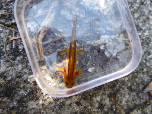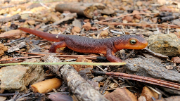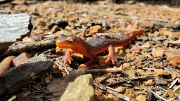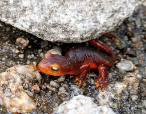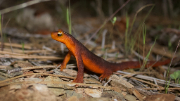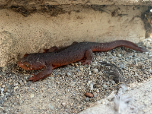|
Sierra Newt (Taricha sierrae)
Description: Its adult length can range from 5 to 8 inches. A stocky, medium-sized salamander with rough, grainy skin in the terrestrial phase, and no costal grooves. Terrestrial adults are yellowish-brown to dark brown above, burnt orange, sometimes yellowish, below. (There is less contrast between dorsal and ventral color on sides than with T. granulosa.) The eyelids and the area below the eyes are lighter than the rest of the head. The iris is silvery to pale yellow. The eyes appear to extend to or beyond the outline of the head when viewed from above, (unlike T. granulosa.) Breeding males develop smooth skin, a flattened tail to aid with swimming, a swollen cloaca, and rough nuptial pads on the undersides of the feet to aid in holding onto females during amplexus. Aquatic larvae are the pond type, light yellow above with two dark regular narrow bands on the back.
Habitat: They prefer less humid climates than the rough-skinned newts. The Sierra newt migrates between aquatic and terrestrial habitats seasonally. Outside the breeding season, the newts are land-dwelling, preferring rock crevices and logs, in habitats such as forests, woodlands, and shrub-lands
Range: Sierra newts exist primarily in between the Cascades and Sierra Nevada, up to about 2000m.
Found in these States:
CA
Diet: Earthworms, snails, slugs, woodlice, bloodworms, mosquito larvae, crickets, other invertebrates, and trout eggs are among the Sierra newt's prey. In an aquarium habitat, earthworms provide the newt with all necessary nutrients. Other natural prey items would benefit the captive newt.
Reproduction: Reproduction occurs generally between March and early May. Typically, the adult newts will return to the pool in which they hatched between January and February. After a mating dance, the male mounts the female and rubs his chin on her nose. He then attaches a spermatophore to the substrate, which she will retrieve into her cloaca.
The egg mass released by the female contains between seven and 30 eggs, and is roughly the consistency of a thick gelatin dessert. Typically, the egg masses are attached to stream plant roots or to rocky crevices in small, pools of slow-moving water, but they have also been known to be attached to underwater rocks or leaf debris. While shallow in a wide sense, these pools are rather deep relative to the average depth of a Southern California stream, varying in depth from about 3.3–6.6 feet.
Adult newts will stay in the pools throughout the breeding season, and can be occasionally found well into the summer. Larvae hatch sometime in early to midsummer, depending on local water temperature. However, the typical incubation length is between 14 and 52 days, varying primarily to water temperatures.
Larvae are difficult to find in streams, as they blend in well with the sandy bottom, to which they usually stay close. After the Larvae period which usually lasts till early fall or late summer, the newt will move to terrestrial habitats till they come back to reproduce in 5 to 8 years.
Status: Listed as Least Concern in view of its wide distribution, tolerance of a broad range of habitats, presumed large population, and because it is unlikely to be declining fast enough to qualify for listing in a more threatened category.
Taxonomy: The Sierra newt was formerly regarded as a subspecies (Taricha torosa sierrae) of the California newt (Taricha torosa). In 2007 it was determined that the two represent "distinct evolutionary lineages".
»» Kingdom: Animalia - Animals
»» Phylum: Chordata - Chordates
»» Subphylum: Vertebrata - Vertebrates
»» Class: Amphibia - (Amphibians)
»» Order: Caudata - Salamanders
»» Family: Salamandridae - Newts
»» Subfamily: Pleurodelinae - Pleurodeline Newts
»» Genus: Taricha
»» Species: Taricha sierrae - Sierra Newt
This article uses material from the Wikipedia article "Sierra Newt", which is released under the Creative Commons Attribution-Share-Alike License 3.0. Content may have been omitted from the original, but no content has been changed or extended.
|
|


